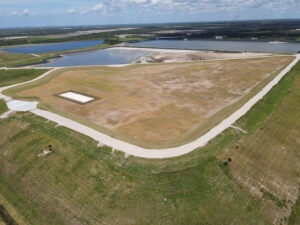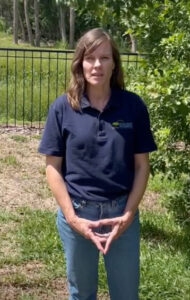Florida DEP agrees to increased oversight of gypsum stacks.
By Johannes Werner
Original Air Date: July 10, 2024
Host: When the watchdog is asleep, wake it up. That’s what five local environmental organizations tried after the Piney Point disaster in Manatee County, by suing the Florida Department of Environmental Protection. The state agency was overseeing the gypsum stack near Port Manatee — a toxic reservoir for byproducts of the process that turns phosphate into fertilizer — that broke in 2021, spilling millions of gallons of wastewater into Tampa Bay. Now, they reached a settlement with the state agency, which they announced on Monday.

The state is paying $100 million to drain the Piney Point gypstack that nearly collapsed. Photo: Florida DEP
Johannes Werner: Emergency responders were able to avoid loss of human life and destruction of property, but for the environment and animals, the results were disastrous. Dr. Abbey Tyrna is executive director of Suncoast Waterkeeper, one of the five plaintiff organizations.
Abbey Tyrna: In April of 2021, over 210 million gallons of polluted wastewater was directly discharged into Tampa Bay, and that led to one of the most concentrated red tide events in recent history, and also the largest fish kill ever documented in Tampa Bay.
JW: The fertilizer company that created the Piney Point site went bankrupt, and over two decades, the gypstack changed owners. During that time, the state let the toxic sludge rise in the reservoir, which led to repeated releases into Tampa Bay, without any oversight, let alone interference.

Abbey Tyrna
AT: The facility was open, and had never been closed, even though it was not actively being utilized. It was left to just kind of sit there with a bunch of very toxic waste just piling up. It had been thought to start closure in 2021, but due to weather events and lack of political will, it never got closed. There had been buyers that came and went, and still no enforcement on behalf of the Florida Department of Environmental Protection to ensure that what remained on site was secure and wouldn’t be able to migrate off site and impact local waters or community health. And so that happened over two decades.
JW: The legal angle of the lawsuit, and the main subject of the settlement was permitting under the Clean Water Act. The plaintiffs alleged that because the owners released polluted gypstack water into the bay, the state should have forced — but failed to do so — the owners of the gypstack to obtain a Clean Water Act permit, which in turn would have allowed for closer oversight. That’s what the state agreed to in this settlement.
AT: The Piney Point facility had been operating without a Clean Water Act permit for decades. Anytime that you have stormwater develop on your site, you must have a permit to move that stormwater off your site. So as stormwater moves off your site, you have to have a permit for whatever pollutants are coming in with the stormwater, and moving out to downstream waters, specifically waters of the state.
And so since the stormwater was moving off site and entering into Tampa Bay, the facility must have a permit to have polluted stormwater move off the site. Unfortunately, for two decades, they didn’t have that. And so therefore, there were no checks and balances as to how much pollution was actually moving off the site into Tampa Bay for over 20 years. And so, the settlement and the lawsuit was largely about this lack of permit. And the settlement was a draft permit and Florida agreeing to having a Clean Water Act permit for the site.
JW: Under the settlement, the state will also $75,000 for the Tampa Bay Estuary Program to monitor water quality in the area where the Piney Point discharges enter Tampa Bay.
In 2021, the state legislature voted to spend $100 million on a cleanup of the near-collapsed gypstack, which is done in part by injecting the diluted sludge deep underground. The lawsuit and settlement was not about the ongoing deepwater well injection. But it still has a positive effect, Tyrna says, because there are still more gypstacks on the site.
AT: There are still gypstacks. They are in the process of closing the plant, so basically they’re going to entomb or encase each of these gypstacks to ensure that an incident like 2021 would never happen again. But during the closure process, that’s how they’re pumping the water into deep well and then, as rainwater continues to enter the site and then move off site, now, that is the water that is being regulated and will continue to be regulated for perpetuity. So right now the permit allows for some extra pollution to go into Tampa Bay during the closure process and it’s assumed then once the plant is completely closed, that the pollution levels will drop down. And so there’ll be another set of regulations and requirements that the site will have to meet once it’s closed. So there’s a set of requirements while it’s closing, and then a set of requirements after it’s closed.
JW: The settlement is limited just to the Piney Point plant. But the Suncoast Waterkeeper is now aiming at the next level, by trying to get the state to declare gypstack sludge as toxic.
AT: Currently, fertilizer production, phosphorus fertilizer production creates this phosphogypsum waste that the state has somehow decided does not meet the definition of hazardous waste. Although, when you look at the definition of hazardous waste and you ask any scientist to look at that definition, fossil gypsum waste certainly would be deemed hazardous. And so, what we’re trying to do now is get the state to reclassify fossil gypsum waste as hazardous, as it should be. And once that happens, then how the waste is dealt with will change, and it’ll be more secure and less able to create an incident like what happened at Piney Point in 2021.
JW: Reporting for WSLR News, this has been Johannes Werner
WSLR News aims to keep the local community informed with our 1/2 hour local news show, quarterly newspaper and social media feeds. The local news broadcast airs on Wednesdays and Fridays at 6pm.